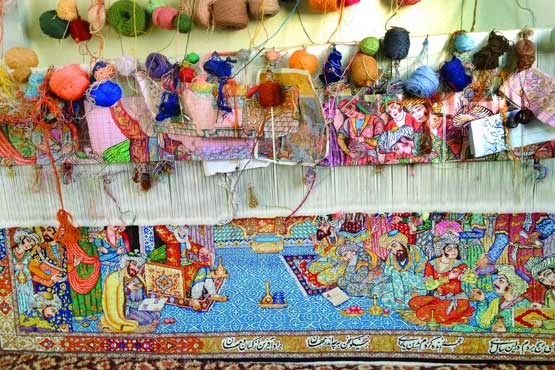The Exquisite Technique of Persian City Carpets
Persian city carpets, renowned for their impeccable quality and intricate designs, are masterpieces of textile art. These rugs are woven in the culturally rich cities of Isfahan, Nain, Tabriz, and Qom, each contributing its unique touch to the storied tradition of Persian carpet weaving. While tribal rugs have been crafted for centuries, Persian city carpets have only been in production for the past 80 to 90 years, yet they have swiftly earned a reputation for being the finest of all Persian carpets.
Origins and Distinctive Qualities Isfahan
Isfahan, a city known for its historical grandeur and architectural marvels, is also a hub for exquisite carpet weaving. Isfahan carpets are characterized by their intricate floral and vine motifs, often inspired by the city’s rich architectural heritage. The designs are typically symmetrical, with central medallions and elaborate borders, showcasing the weavers’ remarkable attention to detail.
Nain
Located in the province of Isfahan, Nain produces some of the most luxurious carpets in the world. Nain carpets are distinguished by their refined aesthetic, featuring soft colour palettes dominated by ivory, blue, and beige. The designs are typically floral, with an emphasis on delicate patterns and precise execution. The high knot density in Nain carpets contributes to their fine texture and exceptional durability.
Tabriz
Tabriz, one of the oldest weaving centres in Iran, is famed for its diverse and sophisticated carpet designs. Tabriz carpets often feature intricate patterns that include medallions, hunting scenes, and detailed landscapes. The craftsmanship is unparalleled, with weavers employing both traditional and contemporary techniques to produce rugs that are both visually stunning and highly durable.
Qom
Qom, known for producing the finest silk carpets, has elevated the art of carpet weaving to new heights. Qom carpets are renowned for their shimmering beauty and intricate designs, often incorporating a mix of wool and silk or being entirely made of silk . The motifs are varied, ranging from floral patterns to elaborate geometric designs, all executed with exquisite precision.
Materials and Expertise
The materials used in Persian city carpets are crucial to their quality and durability. The warp and weft threads are typically made of cotton or silk, providing a sturdy foundation for the intricate designs. The pile, which forms the surface of the carpet, is made of a mixture of wool and silk or, in the case of Qom carpets, pure silk. This combination of materials ensures a plush texture and a lustrous finish that enhances the visual appeal of the carpets.
Variety of Designs Each city brings its unique flavour to carpet designs, resulting in a vast array of styles:
Isfahan : Symmetrical floral patterns with central medallions.Nain : Delicate floral designs in soft colours.Tabriz : Complex patterns including medallions, landscapes, and hunting scenes.Qom : Luxurious silk carpets with intricate floral and geometric patterns.
These designs reflect the cultural heritage and artistic sensibilities of their regions, making each carpet a unique piece of art.
Global Recognition and Value Iran, the birthplace of these magnificent carpets, is globally recognized for producing the finest Persian rugs. Persian city carpets are highly sought after by collectors and enthusiasts for their exceptional craftsmanship, intricate designs, and superior quality. Owning a Persian city carpet is not just about possessing a beautiful rug; it’s about owning a piece of history and a work of art that has been crafted with meticulous care and unparalleled skill.
Persian City Carpets
Persian city carpets from Isfahan, Nain, Tabriz, and Qom represent the pinnacle of carpet weaving. Their combination of exquisite materials, intricate designs, and masterful craftsmanship sets them apart as the finest Persian rugs in the world. These carpets are more than just floor coverings; they are timeless pieces of art that embody the rich cultural heritage of Iran. Whether for their aesthetic appeal, their craftsmanship, or their historical value, Persian city carpets remain a treasured possession and a testament to the enduring legacy of Persian art.

